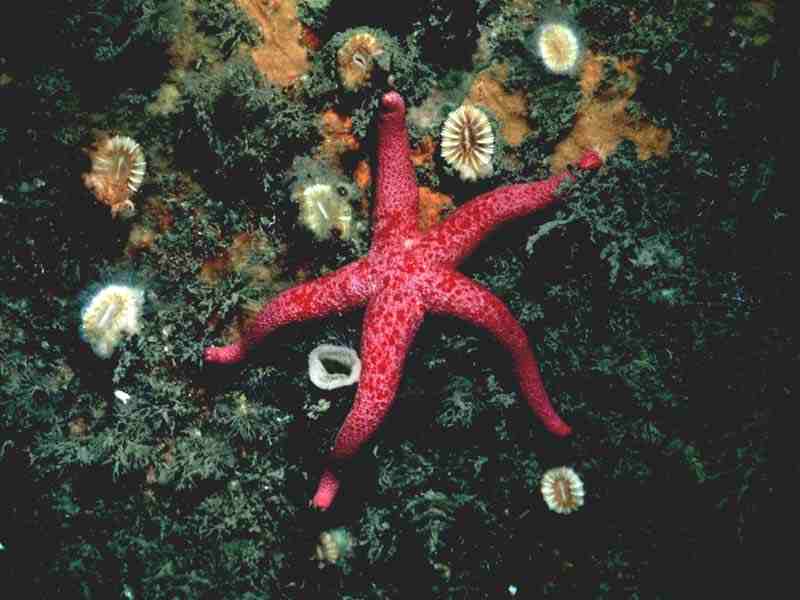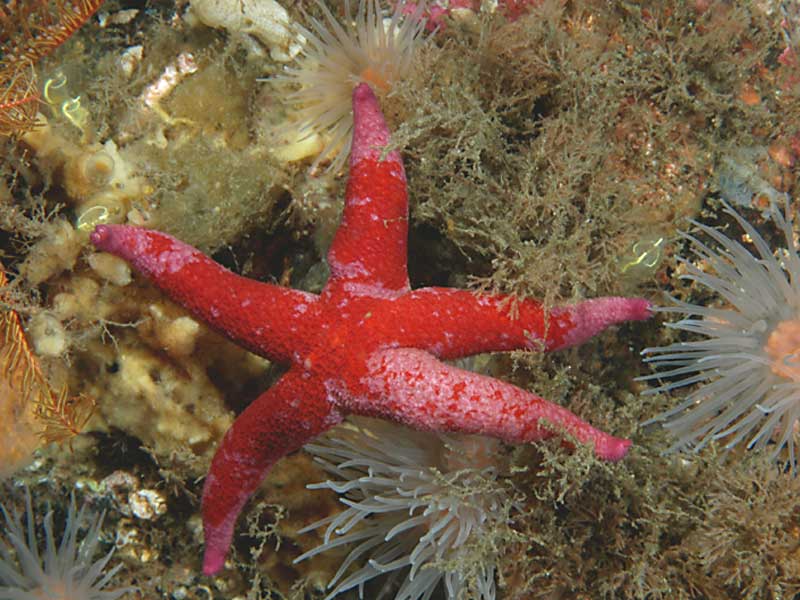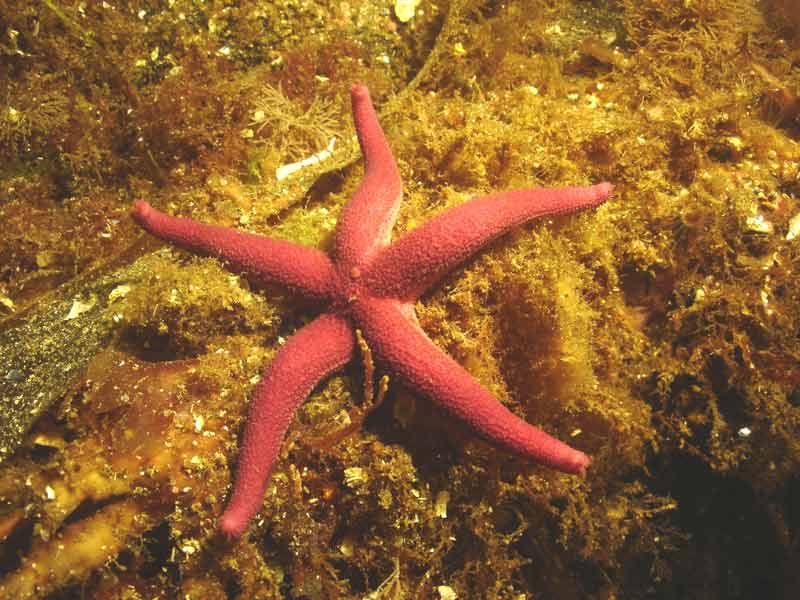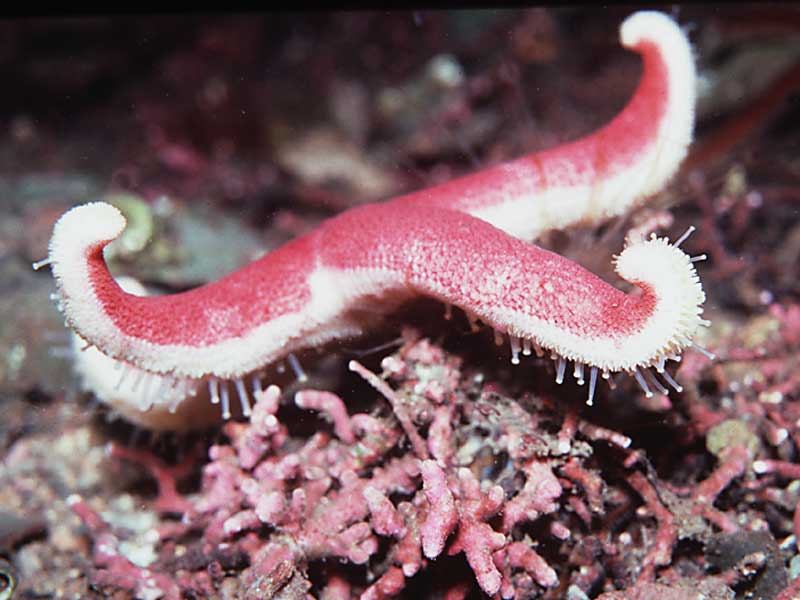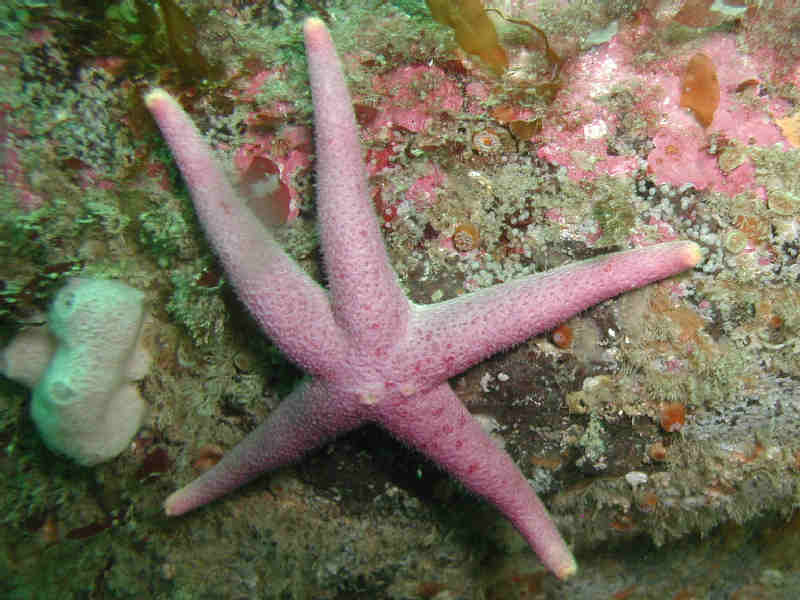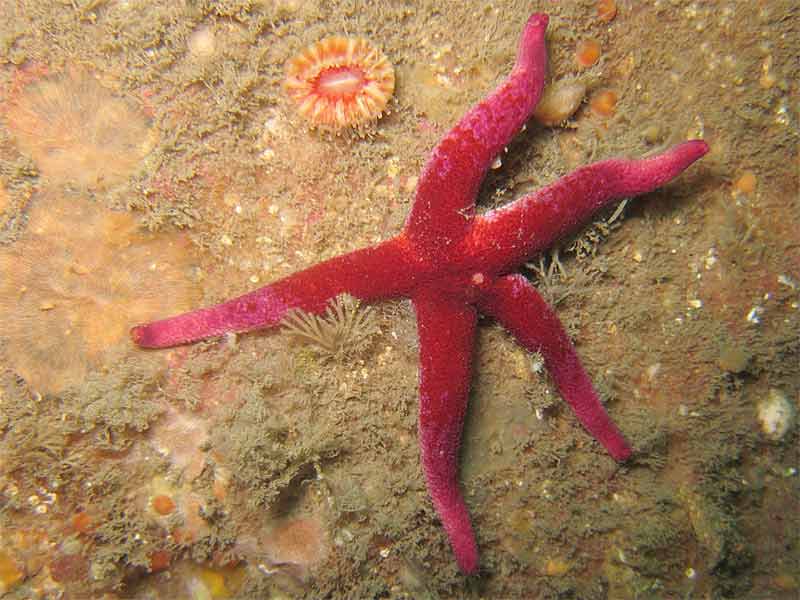Bloody Henry starfish (Henricia oculata)
Distribution data supplied by the Ocean Biodiversity Information System (OBIS). To interrogate UK data visit the NBN Atlas.Map Help
| Researched by | Angus Jackson | Refereed by | Dr Andrew C. Campbell |
| Authority | (Pennant, 1777) | ||
| Other common names | - | Synonyms | - |
Summary
Description
A stiff rigid starfish with a sandpapery texture to the dorsal surface. This species comes in a wide variety of colour forms, reds, browns, purples and yellows. Sometimes the disc and inner portions of the arms is much darker than the outer part of the arms, as though the animal has been splashed with paint. The dorsal spinelets are more opaque and irregular than in Henricia sanguinolenta.
Recorded distribution in Britain and Ireland
All round Ireland except perhaps for the east coast. South-east England round to the west coast northwards to northern Scotland.Global distribution
South, West and North coasts of Britain and Ireland. West Channel and Brittany.Habitat
Found on a variety of substrata on open coasts.Depth range
0 - 100Identifying features
- Five tapering stiff arms.
- Sandpaper like texture.
- Dorsal spines blunt and covered with skin.
Additional information
Sometimes confused with Henricia sanguinolenta.
Listed by
- none -
Biology review
Taxonomy
| Level | Scientific name | Common name |
|---|---|---|
| Phylum | Echinodermata | Starfish, brittlestars, sea urchins & sea cucumbers |
| Class | Asteroidea | Starfish |
| Order | Spinulosida | |
| Family | Echinasteridae | |
| Genus | Henricia | |
| Authority | (Pennant, 1777) | |
| Recent Synonyms | ||
Biology
| Parameter | Data | ||
|---|---|---|---|
| Typical abundance | Data deficient | ||
| Male size range | <200mm | ||
| Male size at maturity | >18mm | ||
| Female size range | >18 mm | ||
| Female size at maturity | |||
| Growth form | Stellate | ||
| Growth rate | 0.3 - 1% body wt/day | ||
| Body flexibility | |||
| Mobility | Crawler or Walker | ||
| Characteristic feeding method | Not relevant, Passive suspension feeder | ||
| Diet/food source | Omnivore | ||
| Typically feeds on | Suspended matter, detritus layer, sponges, hydroids, ectoprocts | ||
| Sociability | Solitary | ||
| Environmental position | Epifaunal | ||
| Dependency | Independent. | ||
| Supports | Host Asterocheres lillyeborgi | ||
| Is the species harmful? | No | ||
Biology information
- Size at maturity refers to the radius. Adults typically around 100 mm.
- Stomach eversion is an important supplement to suspension feeding.
- The parasitic cyclopoid copepod Asterocheres lillyeborgi has more than a 90% occurrence
Habitat preferences
| Parameter | Data |
|---|---|
| Physiographic preferences | Open coast |
| Biological zone preferences | Lower circalittoral, Lower infralittoral, Sublittoral fringe, Upper circalittoral, Upper infralittoral |
| Substratum / habitat preferences | Bedrock, Cobbles, Gravel / shingle, Large to very large boulders, Pebbles, Small boulders |
| Tidal strength preferences | |
| Wave exposure preferences | Exposed, Moderately exposed, Very exposed |
| Salinity preferences | Full (30-40 psu) |
| Depth range | 0 - 100 |
| Other preferences | No text entered |
| Migration Pattern | Non-migratory or resident |
Habitat Information
Henricia oculata is occasionally found exposed to the air at low spring tides (Campbell pers comm.).Life history
Adult characteristics
| Parameter | Data |
|---|---|
| Reproductive type | Gonochoristic (dioecious) |
| Reproductive frequency | Annual protracted |
| Fecundity (number of eggs) | 100-1,000 |
| Generation time | Insufficient information |
| Age at maturity | Not relevant |
| Season | March - April |
| Life span | 2-5 years |
Larval characteristics
| Parameter | Data |
|---|---|
| Larval/propagule type | - |
| Larval/juvenile development | Direct development |
| Duration of larval stage | No information |
| Larval dispersal potential | Greater than 10 km |
| Larval settlement period | Insufficient information |
Life history information
- Females have ripe eggs between March and April, males have mature sperm throughout the year.
- Maturity dependent on size rather than age.
Sensitivity review
The MarLIN sensitivity assessment approach used below has been superseded by the MarESA (Marine Evidence-based Sensitivity Assessment) approach (see menu). The MarLIN approach was used for assessments from 1999-2010. The MarESA approach reflects the recent conservation imperatives and terminology and is used for sensitivity assessments from 2014 onwards.
Physical pressures
Use / to open/close text displayed
| Intolerance | Recoverability | Sensitivity | Evidence / Confidence | |
Substratum loss [Show more]Substratum lossBenchmark. All of the substratum occupied by the species or biotope under consideration is removed. A single event is assumed for sensitivity assessment. Once the activity or event has stopped (or between regular events) suitable substratum remains or is deposited. Species or community recovery assumes that the substratum within the habitat preferences of the original species or community is present. Further details EvidenceThe species is an epifaunal crawler that occupies a broad range of substrata. Loss of the substratum would result in death. Although the adults are mobile they probably don't move long distances so adult immigration is unlikely to play a large role in recovery. The species can live for up to five years and matures at quite small sizes. Up to 500 eggs are broadcast spawned into the water column so larval dispersal potential is considerable. Reproduction occurs over a protracted period so is less likely to be affected by adverse environmental conditions. | High | High | Moderate | Low |
Smothering [Show more]SmotheringBenchmark. All of the population of a species or an area of a biotope is smothered by sediment to a depth of 5 cm above the substratum for one month. Impermeable materials, such as concrete, oil, or tar, are likely to have a greater effect. Further details. EvidenceThe species is able to move by slow crawling. It does not typically live on sediment so smothering by sediment may cause locomotion problems. Crawling back up through the sediment may not be possible. Henricia oculata frequently suspension feeds so changing the substratum for one month would have little effect on the ability to feed. Although the adults are mobile they probably don't move long distances so adult immigration is unlikely to play a large role in recovery. The species can live for up to five years and matures at quite small sizes. Up to 500 eggs are broadcast spawned into the water column so larval dispersal potential is considerable. Reproduction occurs over a protracted period so is less likely to be affected by adverse environmental conditions. | Intermediate | High | Low | Low |
Increase in suspended sediment [Show more]Increase in suspended sedimentBenchmark. An arbitrary short-term, acute change in background suspended sediment concentration e.g., a change of 100 mg/l for one month. The resultant light attenuation effects are addressed under turbidity, and the effects of rapid settling out of suspended sediment are addressed under smothering. Further details EvidenceHenricia oculata frequently suspension feeds, increased siltation may clog or interfere with this mechanism requiring extra energy expenditure to clear the feeding apparatus. Recovery occurs once feeding is no longer impaired, energy expenditure is returned to normal and condition is restored. | Low | Very high | Very Low | Low |
Decrease in suspended sediment [Show more]Decrease in suspended sedimentBenchmark. An arbitrary short-term, acute change in background suspended sediment concentration e.g., a change of 100 mg/l for one month. The resultant light attenuation effects are addressed under turbidity, and the effects of rapid settling out of suspended sediment are addressed under smothering. Further details Evidence | No information | |||
Desiccation [Show more]Desiccation
EvidenceHenricia oculata is generally only found subtidally although is occasionally exposed at low spring tides. If it was exposed to the air it would probably not be able to move fast enough to return to the water rapidly. Although the adults are mobile they probably don't move long distances so adult immigration is unlikely to play a large role in recovery. The species can live for up to five years and matures at quite small sizes. Up to 500 eggs are broadcast spawned into the water column so larval dispersal potential is considerable. Reproduction occurs over a protracted period so is less likely to be affected by adverse environmental conditions. | Intermediate | High | Low | Low |
Increase in emergence regime [Show more]Increase in emergence regimeBenchmark. A one hour change in the time covered or not covered by the sea for a period of one year. Further details EvidenceHenricia oculata is only found subtidally and if the emergence regime changed, it probably has sufficient mobility to move to a location that is not subject to emergence. | Tolerant | Not relevant | Not sensitive | Low |
Decrease in emergence regime [Show more]Decrease in emergence regimeBenchmark. A one hour change in the time covered or not covered by the sea for a period of one year. Further details Evidence | No information | |||
Increase in water flow rate [Show more]Increase in water flow rateA change of two categories in water flow rate (view glossary) for 1 year, for example, from moderately strong (1-3 knots) to very weak (negligible). Further details EvidenceThe species has sufficient mobility to move out of the area of altered water flow. An altered water flow rate may interfere with suspension feeding ability. The species does not rely entirely on passive suspension feeding but is also an active omnivore. Recovery occurs once feeding is no longer impaired and condition is restored. | Low | Very high | Very Low | Low |
Decrease in water flow rate [Show more]Decrease in water flow rateA change of two categories in water flow rate (view glossary) for 1 year, for example, from moderately strong (1-3 knots) to very weak (negligible). Further details Evidence | No information | |||
Increase in temperature [Show more]Increase in temperature
For intertidal species or communities, the range of temperatures includes the air temperature regime for that species or community. Further details EvidenceThe species has quite a restricted global distribution. Long term temperature changes will cause the population to die (or to move location). Rapid, acute temperature increase will probably also cause death. A short term decrease in temperature will probably just cause inactivity. Although the adults are mobile they probably don't move long distances so adult immigration is unlikely to play a large role in recovery. The species can live for up to five years and matures at quite small sizes. Up to 500 eggs are broadcast spawned into the water column so larval dispersal potential is considerable. Reproduction occurs over a protracted period so is less likely to be affected by adverse environmental conditions. | High | High | Moderate | Low |
Decrease in temperature [Show more]Decrease in temperature
For intertidal species or communities, the range of temperatures includes the air temperature regime for that species or community. Further details Evidence | No information | |||
Increase in turbidity [Show more]Increase in turbidity
EvidenceBehaviour is not dependent on ambient light. The species is found down to 100 metres where light availability is very limited. | Tolerant | Not relevant | Not sensitive | Low |
Decrease in turbidity [Show more]Decrease in turbidity
Evidence | No information | |||
Increase in wave exposure [Show more]Increase in wave exposureA change of two ranks on the wave exposure scale (view glossary) e.g., from Exposed to Extremely exposed for a period of one year. Further details EvidenceWave action in extremely exposed areas may be too great for the species to maintain position on substrata. A change of two ranks means that the species is likely to be subject to lower wave exposure conditions than its preferred range. Although the adults are mobile they probably don't move long distances so adult immigration is unlikely to play a large role in recovery. The species can live for up to five years and matures at quite small sizes. Up to 500 eggs are broadcast spawned into the water column so larval dispersal potential is considerable. Reproduction occurs over a protracted period so is less likely to be affected by adverse environmental conditions. | Intermediate | High | Low | Low |
Decrease in wave exposure [Show more]Decrease in wave exposureA change of two ranks on the wave exposure scale (view glossary) e.g., from Exposed to Extremely exposed for a period of one year. Further details Evidence | No information | |||
Noise [Show more]Noise
EvidenceThe species is unlikely to respond to noise vibrations | Tolerant | Not relevant | Not sensitive | Low |
Visual presence [Show more]Visual presenceBenchmark. The continuous presence for one month of moving objects not naturally found in the marine environment (e.g., boats, machinery, and humans) within the visual envelope of the species or community under consideration. Further details EvidenceStarfish have photoreceptors but cannot resolve moving objects so will not respond to visual disturbance. | Tolerant | Not relevant | Not sensitive | Low |
Abrasion & physical disturbance [Show more]Abrasion & physical disturbanceBenchmark. Force equivalent to a standard scallop dredge landing on or being dragged across the organism. A single event is assumed for assessment. This factor includes mechanical interference, crushing, physical blows against, or rubbing and erosion of the organism or habitat of interest. Where trampling is relevant, the evidence and trampling intensity will be reported in the rationale. Further details. EvidencePhysical disturbance or impact by due to a scallop dredge is likely to cause some physical damage to Henricia oculata but starfish have well documented regenerative abilities (see Asterias rubens). | Low | Very high | Very Low | Low |
Displacement [Show more]DisplacementBenchmark. Removal of the organism from the substratum and displacement from its original position onto a suitable substratum. A single event is assumed for assessment. Further details EvidenceThe species is mobile and displacement would not affect the species. | Tolerant | Not relevant | Not sensitive | Low |
Chemical pressures
Use [show more] / [show less] to open/close text displayed
| Intolerance | Recoverability | Sensitivity | Evidence / Confidence | |
Synthetic compound contamination [Show more]Synthetic compound contaminationSensitivity is assessed against the available evidence for the effects of contaminants on the species (or closely related species at low confidence) or community of interest. For example:
The evidence used is stated in the rationale. Where the assessment can be based on a known activity then this is stated. The tolerance to contaminants of species of interest will be included in the rationale when available; together with relevant supporting material. Further details. EvidenceInsufficientinformation | No information | No information | No information | Not relevant |
Heavy metal contamination [Show more]Heavy metal contaminationEvidenceInsufficientinformation | No information | No information | No information | Not relevant |
Hydrocarbon contamination [Show more]Hydrocarbon contaminationEvidenceInsufficientinformation | No information | No information | No information | Not relevant |
Radionuclide contamination [Show more]Radionuclide contaminationEvidenceInsufficientinformation | No information | No information | No information | Not relevant |
Changes in nutrient levels [Show more]Changes in nutrient levelsEvidenceInsufficientinformation | No information | No information | No information | Not relevant |
Increase in salinity [Show more]Increase in salinity
EvidenceSpecies lives only in fully saline habitats. A reduction of one salinity rank would result in the species being exposed to conditions outside its preferred range. Although the adults are mobile they probably don't move long distances so adult immigration is unlikely to play a large role in recovery. The species can live for up to five years and matures at quite small sizes. Up to 500 eggs are broadcast spawned into the water column so larval dispersal potential is considerable. Reproduction occurs over a protracted period so is less likely to be affected by adverse environmental conditions. | Intermediate | Moderate | Moderate | Low |
Decrease in salinity [Show more]Decrease in salinity
Evidence | No information | |||
Changes in oxygenation [Show more]Changes in oxygenationBenchmark. Exposure to a dissolved oxygen concentration of 2 mg/l for one week. Further details. EvidenceCole et al. (1999) suggest possible effects on marine species below 4 mg/l and probable effects below 2mg/l. There is no information about Henricia oculata tolerance to changes in oxygenation.. | Intermediate | Moderate | Moderate | Low |
Biological pressures
Use [show more] / [show less] to open/close text displayed
| Intolerance | Recoverability | Sensitivity | Evidence / Confidence | |
Introduction of microbial pathogens/parasites [Show more]Introduction of microbial pathogens/parasitesBenchmark. Sensitivity can only be assessed relative to a known, named disease, likely to cause partial loss of a species population or community. Further details. EvidenceInsufficientinformation | No information | No information | No information | Not relevant |
Introduction of non-native species [Show more]Introduction of non-native speciesSensitivity assessed against the likely effect of the introduction of alien or non-native species in Britain or Ireland. Further details. EvidenceInsufficientinformation | No information | No information | No information | Not relevant |
Extraction of this species [Show more]Extraction of this speciesBenchmark. Extraction removes 50% of the species or community from the area under consideration. Sensitivity will be assessed as 'intermediate'. The habitat remains intact or recovers rapidly. Any effects of the extraction process on the habitat itself are addressed under other factors, e.g. displacement, abrasion and physical disturbance, and substratum loss. Further details. EvidenceIt is very unlikely that this species would be extracted. | Not relevant | Not relevant | Not relevant | Low |
Extraction of other species [Show more]Extraction of other speciesBenchmark. A species that is a required host or prey for the species under consideration (and assuming that no alternative host exists) or a keystone species in a biotope is removed. Any effects of the extraction process on the habitat itself are addressed under other factors, e.g. displacement, abrasion and physical disturbance, and substratum loss. Further details. EvidenceThe species has no known obligate relationships. | Not relevant | Not relevant | Not relevant | Low |
Additional information
Importance review
Policy/legislation
- no data -
Status
| National (GB) importance | - | Global red list (IUCN) category | - |
Non-native
| Parameter | Data |
|---|---|
| Native | - |
| Origin | - |
| Date Arrived | - |
Importance information
-none-Bibliography
Brun, E., 1976. Ecology and taxonomic position of Henricia oculata Pennant. Thalassia Jugoslavica 12, 51-64.
Campbell, A., 1994. Seashores and shallow seas of Britain and Europe. London: Hamlyn.
Howson, C.M. & Picton, B.E., 1997. The species directory of the marine fauna and flora of the British Isles and surrounding seas. Belfast: Ulster Museum. [Ulster Museum publication, no. 276.]
Nichols, D., 1969. Echinoderms (4th ed.). London: Hutchinson & Co.
Datasets
Centre for Environmental Data and Recording, 2018. Ulster Museum Marine Surveys of Northern Ireland Coastal Waters. Occurrence dataset https://www.nmni.com/CEDaR/CEDaR-Centre-for-Environmental-Data-and-Recording.aspx accessed via NBNAtlas.org on 2018-09-25.
Fenwick, 2018. Aphotomarine. Occurrence dataset http://www.aphotomarine.com/index.html Accessed via NBNAtlas.org on 2018-10-01
Fife Nature Records Centre, 2018. St Andrews BioBlitz 2014. Occurrence dataset: https://doi.org/10.15468/erweal accessed via GBIF.org on 2018-09-27.
Fife Nature Records Centre, 2018. St Andrews BioBlitz 2015. Occurrence dataset: https://doi.org/10.15468/xtrbvy accessed via GBIF.org on 2018-09-27.
Fife Nature Records Centre, 2018. St Andrews BioBlitz 2016. Occurrence dataset: https://doi.org/10.15468/146yiz accessed via GBIF.org on 2018-09-27.
Isle of Wight Local Records Centre, 2017. IOW Natural History & Archaeological Society Marine Invertebrate Records 1853- 2011. Occurrence dataset: https://doi.org/10.15468/d9amhg accessed via GBIF.org on 2018-09-27.
Manx Biological Recording Partnership, 2017. Isle of Man wildlife records from 01/01/2000 to 13/02/2017. Occurrence dataset: https://doi.org/10.15468/mopwow accessed via GBIF.org on 2018-10-01.
Manx Biological Recording Partnership, 2022. Isle of Man historical wildlife records 1990 to 1994. Occurrence dataset:https://doi.org/10.15468/aru16v accessed via GBIF.org on 2024-09-27.
NBN (National Biodiversity Network) Atlas. Available from: https://www.nbnatlas.org.
OBIS (Ocean Biodiversity Information System), 2025. Global map of species distribution using gridded data. Available from: Ocean Biogeographic Information System. www.iobis.org. Accessed: 2025-05-09
Outer Hebrides Biological Recording, 2018. Invertebrates (except insects), Outer Hebrides. Occurrence dataset: https://doi.org/10.15468/hpavud accessed via GBIF.org on 2018-10-01.
South East Wales Biodiversity Records Centre, 2023. SEWBReC Marine and other Aquatic Invertebrates (South East Wales). Occurrence dataset:https://doi.org/10.15468/zxy1n6 accessed via GBIF.org on 2024-09-27.
Yorkshire Wildlife Trust, 2018. Yorkshire Wildlife Trust Shoresearch. Occurrence dataset: https://doi.org/10.15468/1nw3ch accessed via GBIF.org on 2018-10-02.
Citation
This review can be cited as:
Last Updated: 24/04/2008

